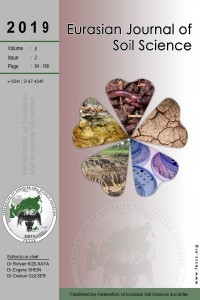
Eurasian Journal of Soil Science
Yazarlar: Biser HRİSTOV, Ekaterina FİLCHEVA
Konular:Fen
DOI:10.18393/ejss.284267
Anahtar Kelimeler:Soil organic matter,Soil carbon,Pedoclimate,Soil temperature,Moisture regimes
Özet: The present paper focused on content, quality and composition of soil organic matter in different pedoclimatic zones of Bulgaria. The country has temperate continental climate with Mediterranean influence. There are six combinations of soil temperature and moisture regimes over the territory of Bulgaria, such as Thermic-Xeric, Mesic-Xeric, Mesic-Ustic, Mesic-Udic, Cryic-Udic and Pergelic – Udic. Typical soil types for Bulgaria are Chernozems, Luvisols. Vertisols, Cambisols, Phaeozems, Leptosols, Regosols, Planosols, Umbrisols and etc. Fifteen soil profiles were studied which are representative for the area. The content and composition of organic matter were determined according to the method of Kononova-Belchikova. The purpose of this study is to determine the influence of pedoclimatic conditions over soil organic matter content and composition of various areas with different soil cover, vegetation, management and etc. Grouping soil types in different soil temperature and moisture regimes shows that there are similarities in soil carbon content and composition. Soils developed under cooler and moister conditions accumulate more organic carbon. In such areas the content of organic carbon can reach about 255 t.ha-1 in a surface horizon and the type of humus is predominantly Fulvic. Respectively, soils developed under dry and warmer conditions have lower organic carbon content and the type of humus is usually Humic.